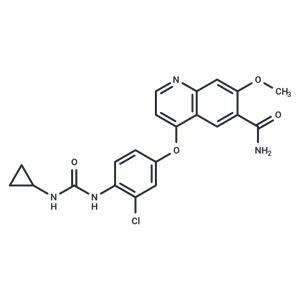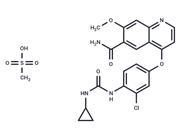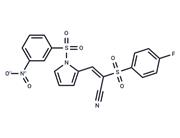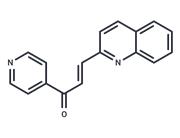| Name | Lenvatinib |
| Description | Lenvatinib (E7080) is a multi-target receptor tyrosine kinase inhibitor that inhibits VEGFR1-3, FGFR1-4, KIT, PDGFR, and RET, and has oral activity. Lenvatinib has the strongest inhibitory activity on VEGFR2 and VEGFR3 (IC50=4/5.2 nM). Lenvatinib has strong anti-tumor activity. |
| Cell Research | HUVECs (1,000 cells in each well in serum-free medium containing 2% fetal bovine serum) and L6 rat skeletal muscle myoblasts (5,000 cells in each well in serum-free DMEM) are dispensed in a 96-well plate and incubated overnight. E7080 and either VEGF (20 ng/mL) or FGF-2 (20 ng/mL) containing 2% fetal bovine serum and PDGFβ (40 ng/mL) are added to each well. Cells are incubated for 3 days and then the ratios of surviving cells are measured by WST-1 reagent. For proliferation assay, samples are duplicated and three separate experiments are done. (Only for Reference) |
| Kinase Assay | In vitro kinase assay [1]: Tyrosine kinase assays are performed by HTRF (KDR, VEGFR1, FGFR1, c-Met, EGFR) and ELISA (PDGFRβ), using the recombinant kinase domains of receptors. In both assays, 4 μL of serial dilutions of E7080 are mixed in a 96-well round plate with 10 μL of enzyme, 16 μL of poly (GT) solution (250 ng) and 10 μL of ATP solution (1 μM ATP) (final concentration of DMSO is 0.1%). In wells for blanks, no enzyme is added. In control wells no test article is added. The kinase reaction is initiated by adding ATP solution to each well. After 30-minute incubation at 30°C, the reaction is stopped by adding 0.5 M EDTA (10 μL/well) to the reaction mixture in each well. Dilution buffer adequate to each kinase assay is added to the reaction mixture. In the HTRF assay, 50 μL of the reaction mixture is transferred to a 96-well 1/2 area black EIA/RIA plate, HTRF solution (50 μL/well) is added to the reaction mixture, and then kinase activity is determined by measurement of fluorescence with a time-resolved fluorescence detector at an excitation wavelength of 337 nm and an emission wavelengths of 620 and 665 nm. In the ELISA, 50 μL of the reaction mixture is incubated in avidin coated 96-well polystyrene plates at room temperature for 30 minutes. After washing with wash buffer, PY20-HRP solution (70 μL/well) is added and the reaction mixture is incubated at room temperature for 30 minutes. After washing with wash buffer, TMB reagent (100 μL/well) is added to each well. After several minutes (10–30 minutes), 1 M H3PO4 (100 μL/well) is added to each well. Kinase activity is determined by measurement of absorbance at 450 nm with a microplate reader. |
| In vitro | METHODS: Six human tumor cells, A375, DU145, DX3, KM12C, SK23, and U2OS, were treated with Lenvatinib (1-100 μM) for 72 h. Cell viability was measured by MTT.
RESULTS: In most cell lines, Lenvatinib inhibited proliferation only at high concentrations (IC50 23.6-44.17 μM), while the IC50 in the KM12C cell line was 9.54 μM. [1]
METHODS: Human umbilical vein endothelial cells HUVECs were treated with Lenvatinib (0.16-20 nM) for 1 h, followed by stimulation with SCF or VEGF (20 ng/mL) for 5 min, and the expression levels of target proteins were detected by Western Blot.
RESULTS: Ligand-induced phosphorylation of both KIT and KDR was inhibited by Lenvatinib. [2] |
| In vivo | METHODS: To assay antitumor activity in vivo, Lenvatinib (30-100 mg/kg in 0.5% methylcellulose) was orally administered twice daily for twenty-one days to BALB/c nude mice harboring human small cell lung cancer tumor H146.
RESULTS: Oral administration of Lenvatinib inhibited the growth of H146 tumors in a dose-dependent manner and caused tumor regression at 100 mg/kg. [2]
METHODS: To test the antitumor activity in vivo, Lenvatinib (100 mg/kg) was orally administered once daily for eight weeks to nude mice harboring human mammary carcinoma tumor MDA-MB-231.
RESULTS: Lenvatinib inhibited metastasis to regional lymph nodes and distant lungs in the MDA-MB-231 xenograft model.Lenvatinib decreased angiogenesis and lymphangiogenesis in established metastatic nodes of MDA-MB-231 tumors in lymph nodes. [3] |
| Storage | store at low temperature | Powder: -20°C for 3 years | Shipping with blue ice. |
| Solubility Information | DMSO : 15 mg/mL (35.14 mM), Sonication is recommended.(The compound is unstable in solution, please use soon.)
Ethanol : < 1 mg/mL (insoluble or slightly soluble)
10% DMSO+40% PEG300+5% Tween 80+45% Saline : 1.9 mg/mL (4.45 mM), Please add co-solvents sequentially, clarifying the solution as much as possible before adding the next one. Dissolve by heating and/or sonication if necessary. Working solution is recommended to be prepared and used immediately.
|
| Keywords | SCFR | PDGFR | CD117 | Platelet-derived growth factor receptor | Fibroblast growth factor receptor | RET | Lenvatinib | inhibit | c-Kit | E-7080 | VEGFR | E 7080 | FGFR | Inhibitor | Vascular endothelial growth factor receptor |
| Inhibitors Related | Ribociclib | Gilteritinib | Amlexanox | Nintedanib | Regorafenib monohydrate | Sorafenib | Ferulic Acid | Regorafenib | Formononetin | Imatinib | Pazopanib | Axitinib |
| Related Compound Libraries | Bioactive Compound Library | Membrane Protein-targeted Compound Library | EMA Approved Drug Library | Kinase Inhibitor Library | Tyrosine Kinase Inhibitor Library | Anti-Cancer Clinical Compound Library | Drug Repurposing Compound Library | FDA-Approved Drug Library | FDA-Approved Kinase Inhibitor Library | Anti-Cancer Approved Drug Library | Bioactive Compounds Library Max | Anti-Cancer Active Compound Library |

 United States
United States



